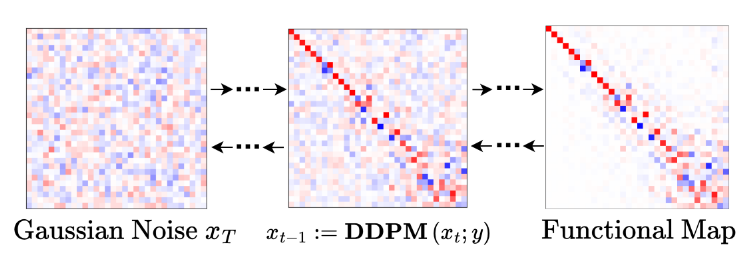Denoising Functional Maps: Diffusion Models for Shape Correspondence
Authored by Aleksei Zhuravlev, Zorah Lähner, Vladislav Golyanik
Published in IEEE Conference on Computer Vision and Pattern Recognition (CVPR) 2025

Abstract
Estimating correspondences between pairs of deformable shapes remains a challenging problem. Despite substantial progress, existing methods lack broad generalization capabilities and require category-specific training data. To address these limitations, we propose a fundamentally new approach to shape correspondence based on denoising diffusion models. In our method, a diffusion model learns to directly predict the functional map, a low-dimensional representation of a point-wise map between shapes. We use a large dataset of synthetic human meshes for training and employ two steps to reduce the number of functional maps that need to be learned. First, the maps refer to a template rather than shape pairs. Second, the functional map is defined in a basis of eigenvectors of the Laplacian, which is not unique due to sign ambiguity. Therefore, we introduce an unsupervised approach to select a specific basis by correcting the signs of eigenvectors based on surface features. Our approach achieves competitive performance on standard human datasets, meshes with anisotropic connectivity, non-isometric humanoid shapes, as well as animals compared to existing descriptor-based and large-scale shape deformation methods.
Resources
Bibtex
@inproceedings{ zhuravlev2025denoise,
author = { Aleksei Zhuravlev and Zorah Lähner and Vladislav Golyanik },
title = { Denoising Functional Maps: Diffusion Models for Shape Correspondence },
booktitle = { IEEE Conference on Computer Vision and Pattern Recognition (CVPR) },
year = { 2025 },
}